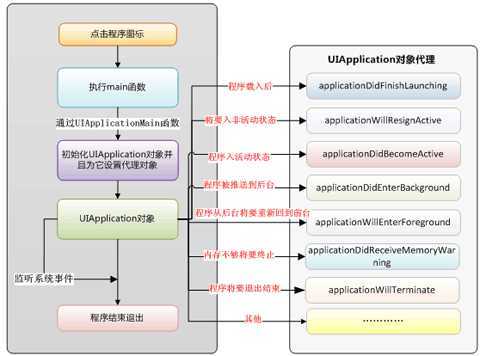标签:style blog http color os strong 文件 数据


int main(int argc, char * argv[]) { @autoreleasepool { return UIApplicationMain(argc, argv, nil, NSStringFromClass([XYZAppDelegate class])); } }
// If nil is specified for principalClassName, the value for NSPrincipalClass from the Info.plist is used. If there is no // NSPrincipalClass key specified, the UIApplication class is used. The delegate class will be instantiated using init. UIKIT_EXTERN int UIApplicationMain(int argc, char *argv[], NSString *principalClassName, NSString *delegateClassName);
argc和argv是为了与C语言保持一致,在这没用到,不详述。
后面两个参数为principalClassName(主要类名)和delegateClassName(委托类名)。
如果principalClassName是nil,那么它的值将从Info.plist中获取,如果Info.plist中没有,则默认为UIApplication。principalClass这个类除了管理整个程序的生命周期之外什么都不做,它只赋值监听事件然后交给delegateClass去做。
而delegateClass将在工程新建时实例化一个对象。
NSStringFromClass([XYZAppDelegate class])
相当于@"XYZAppDelegate"。
注意代码中的官方注释。

- (BOOL)application:(UIApplication *)application didFinishLaunchingWithOptions:(NSDictionary *)launchOptions { // Override point for customization after application launch. NSLog(@"didFinishLaunchingWithOptions"); return YES; } - (void)applicationWillResignActive:(UIApplication *)application { // Sent when the application is about to move from active to inactive state. This can occur for certain types of temporary interruptions (such as an incoming phone call or SMS message) or when the user quits the application and it begins the transition to the background state. // Use this method to pause ongoing tasks, disable timers, and throttle down OpenGL ES frame rates. Games should use this method to pause the game. NSLog(@"WillResignActive"); } - (void)applicationDidEnterBackground:(UIApplication *)application { // Use this method to release shared resources, save user data, invalidate timers, and store enough application state information to restore your application to its current state in case it is terminated later. // If your application supports background execution, this method is called instead of applicationWillTerminate: when the user quits. NSLog(@"DidEnterBackground"); } - (void)applicationWillEnterForeground:(UIApplication *)application { // Called as part of the transition from the background to the inactive state; here you can undo many of the changes made on entering the background. NSLog(@"WillEnterForeground"); } - (void)applicationDidBecomeActive:(UIApplication *)application { // Restart any tasks that were paused (or not yet started) while the application was inactive. If the application was previously in the background, optionally refresh the user interface. NSLog(@"DidBecomeActive"); } - (void)applicationWillTerminate:(UIApplication *)application { // Called when the application is about to terminate. Save data if appropriate. See also applicationDidEnterBackground:. NSLog(@"WillTerminate"); }
启动程序
2014-07-28 15:22:39.883 LifeCycle[3024:a0b] didFinishLaunchingWithOptions
2014-07-28 15:22:39.887 LifeCycle[3024:a0b] DidBecomeActive
按下Home键
2014-07-28 15:22:43.130 LifeCycle[3024:a0b] WillResignActive
2014-07-28 15:22:43.131 LifeCycle[3024:a0b] DidEnterBackground
重新点击程序
2014-07-28 15:22:44.380 LifeCycle[3024:a0b] WillEnterForeground
2014-07-28 15:22:44.380 LifeCycle[3024:a0b] DidBecomeActive
1.application:didFinishLaunchingWithOptions:
程序首次已经完成启动时执行,若直接启动,launchOptions中没有数据;否则,launchOptions将包含对应方式的内容(比如从微信中启动节奏大师--)。
2.applicationWillResignActive(将进入后台)
程序将要失去Active状态时调用,比如按下Home键或有电话信息进来。对应applicationWillEnterForeground(将进入前台),这个方法用来
3.applicationDidEnterBackground(已经进入后台)
程序已经进入后台时调用,对应applicationDidBecomeActive(已经变成前台),这个方法用来
4.applicationWillEnterForeground(将进入前台)
程序即将进去前台时调用,对应applicationWillResignActive(将进入后台)。这个方法用来撤销applicationWillResignActive中做的改变。
5.applicationDidBecomeActive(已经进入前台)
程序已经变为Active(前台)时调用。对应applicationDidEnterBackground(已经进入后台)。若程序之前在后台,最后在此方法内刷新用户界面。
6.applicationWillTerminate
程序即将退出时调用。记得保存数据,如applicationDidEnterBackground方法一样。
IOS Application生命周期,布布扣,bubuko.com
标签:style blog http color os strong 文件 数据
原文地址:http://www.cnblogs.com/chenyg32/p/3873301.html